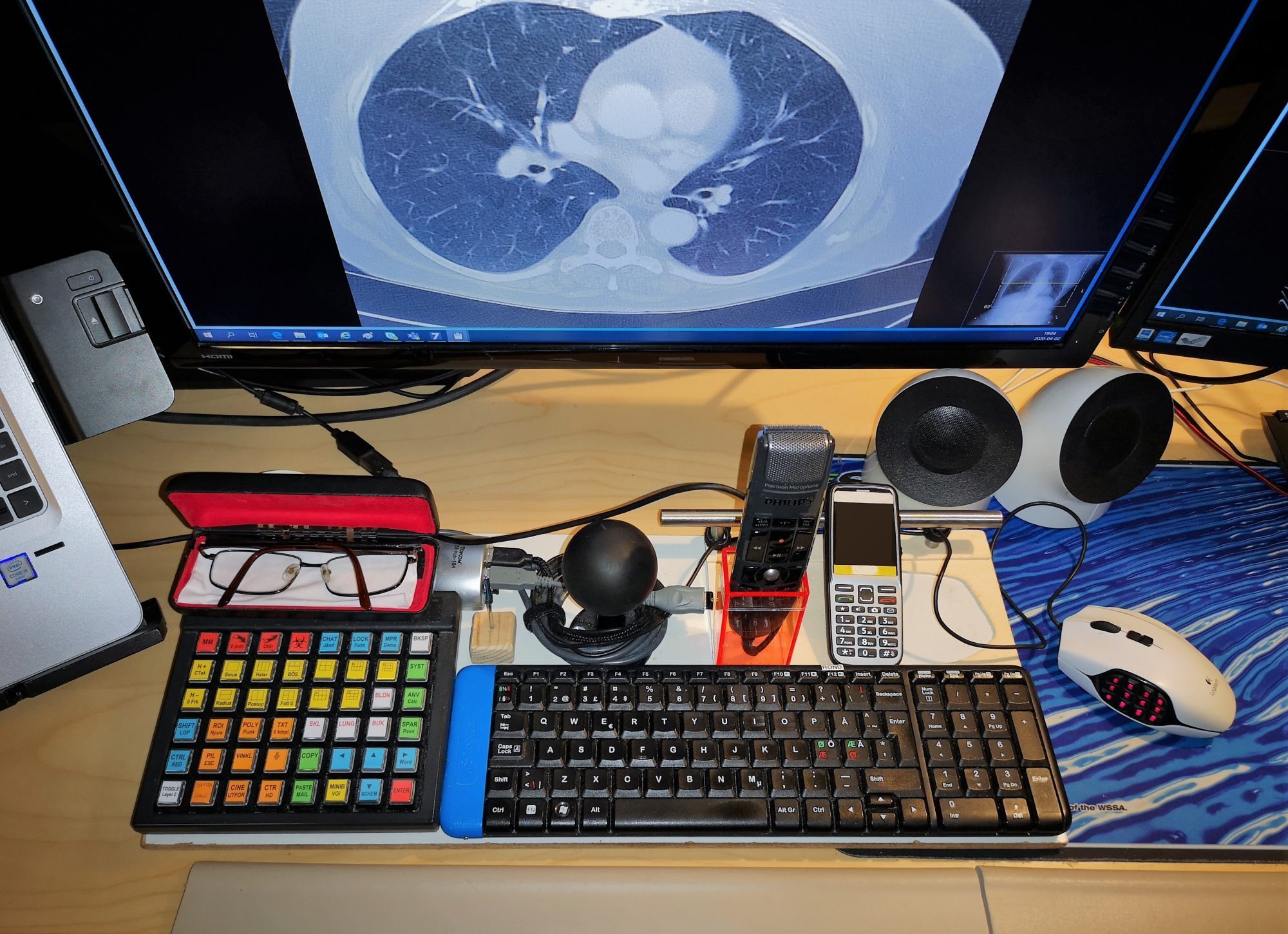In a previous article, Mattias Mjöman, a radiologist at Region Skåne, described how the COVID-19 situation had forced him to work from home. Many readers were amazed by the workstation he had built and reached out to us to learn more. In this follow-up interview, we focus solely on Mattias’ set-up—how it is built and the advantages it brings. He also provides some advice for radiologists who want to adjust their current workstations to make their daily lives easier.
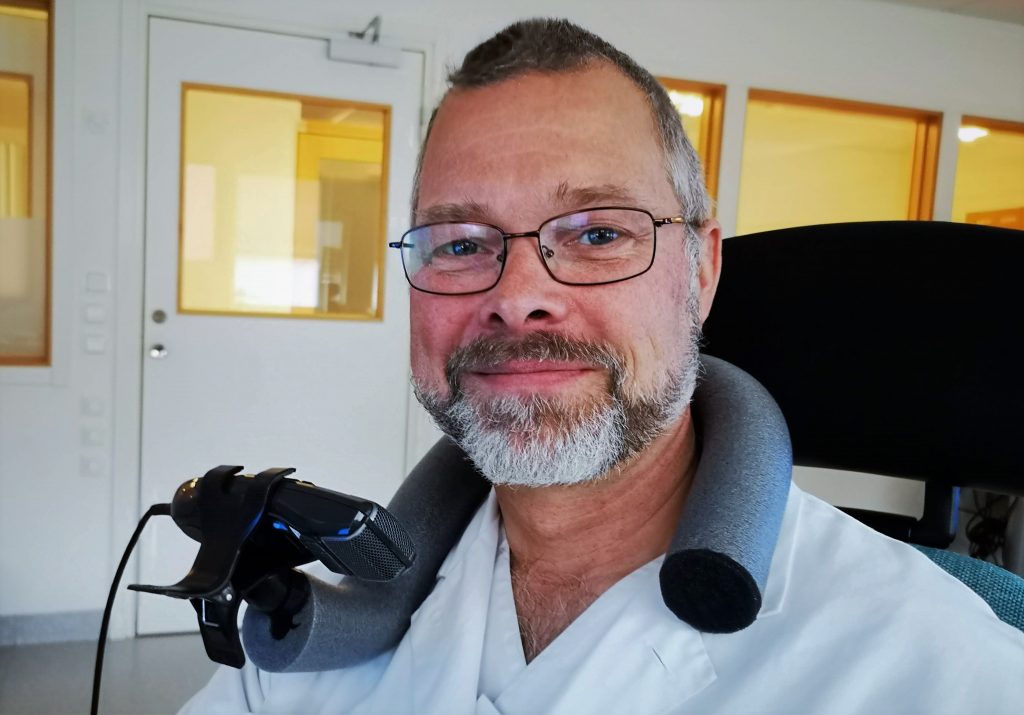
Sectra: Can you tell us more about your special workstation, and how it all started?
Mattias: Well, I have always been keen on finding solutions and ways to do things more efficiently. About eight years ago, when I was working with the standard mouse and keyboard, I experienced some shortcomings. As a former video game player, I knew that there were a lot of special devices out there that could be used to optimize my workstation. So, I gave it a shot, and since then it has developed over time.
The tilting scrolling wheel on the mouse has probably saved me hundreds of hours over the years.
Can you go into a bit more detail about the different components?
The mouse
I started with the mouse, which is of a gaming type called Logitech g600. It allows me to program any shortcuts I want and assign these to the buttons on its sides. These shortcuts help me to automate repetitive tasks and minimize moving the cursor over the screen—mouse miles. For example, I use the small buttons by the thumb for the most common functionality, such as:
- Update worklists
- Show worklists
- Sync image stacks
- Different measurements in images
- Length measurements
- Switch to matrix window or the information window
- Start and stop dictating
- Show attached documents
- Reset image to default view
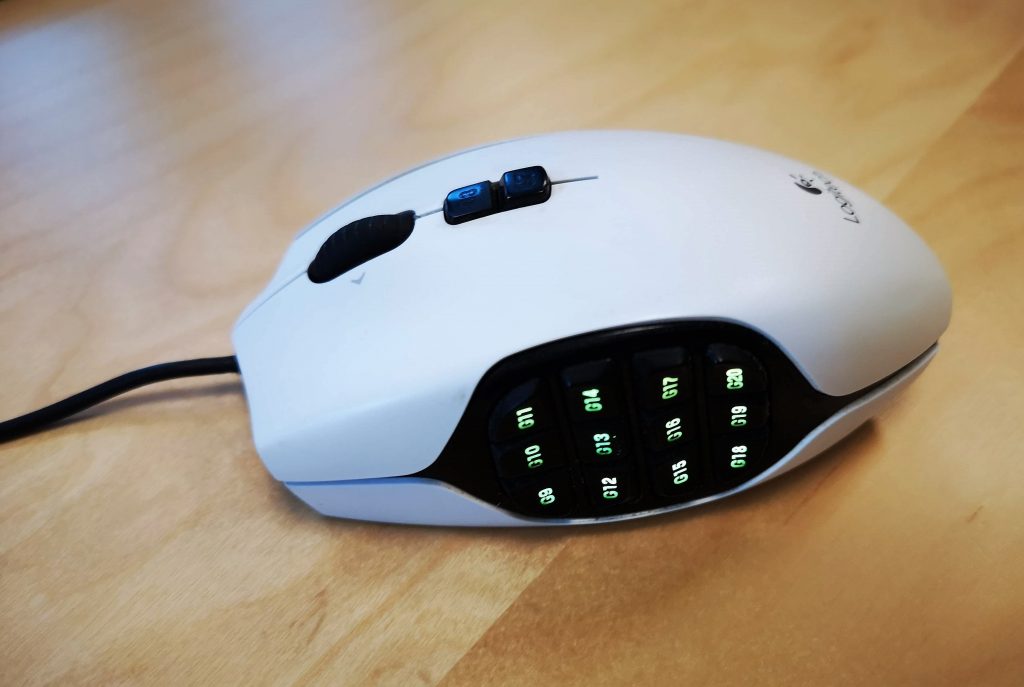
My favorite time-saving feature of the mouse is that the scroll wheel tilts. I use this when switching between different layouts in a hanging, and it has saved me hundreds of hours.
A fun fact is that I was so fond of the mouse in the beginning that I purchased three of them, in case it broke, and the model could no longer be purchased. After eight years, I am still on my very first one.
The keyboard
The keyboard I have added is called Genovation CP48; it is programmable and has an internal memory. It has 48 buttons and can hold a total of 96 shortcuts thanks to a toggle button that gives me two layers to program.
I use the first layer for functionality such as:
- Different split screen configurations
- Switch between the most common window level presets
- Access to common tools such as angle measurements, annotate text, add arrow etc.
- Save hanging
- Open chat
The second layer is instead used for the matrix window, such as:
- Changing hangings for different exam types (lung, thorax, skeletal, etc.)
- Measuring angles
- Add short standard phrases (e.g. “latest examination performed by”)
- Fetching my schedule or go to my email inbox
- Going to specific website URLs
I use this together with the regular QWERTY keyboard and I have memorized all the keys, so working is a bit like playing the piano.
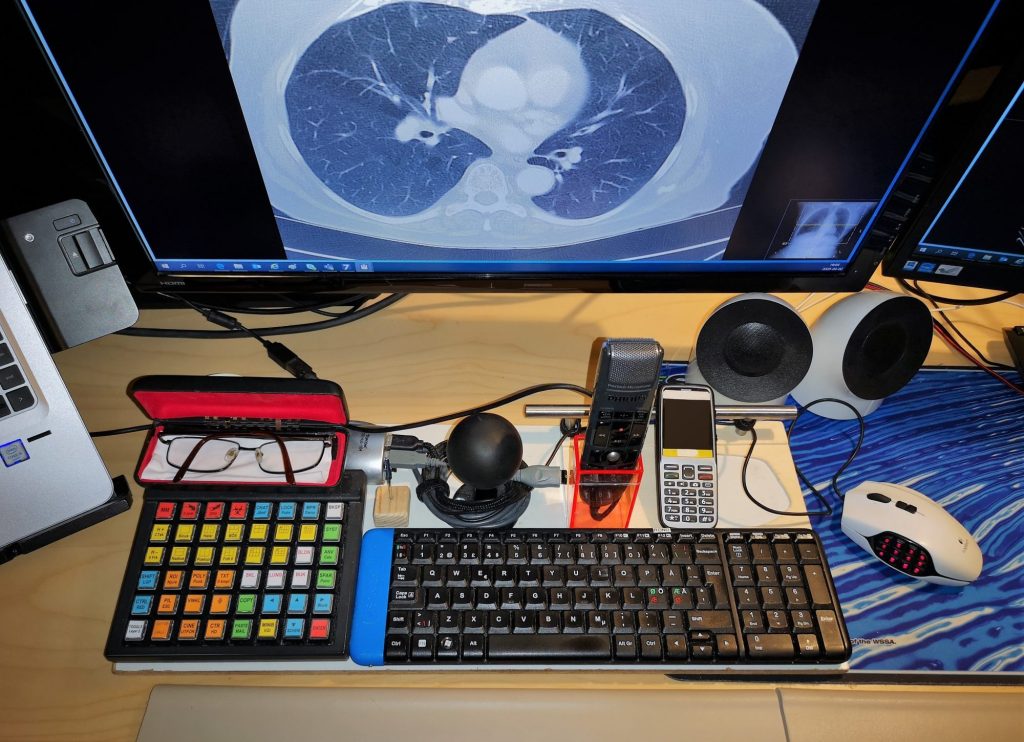
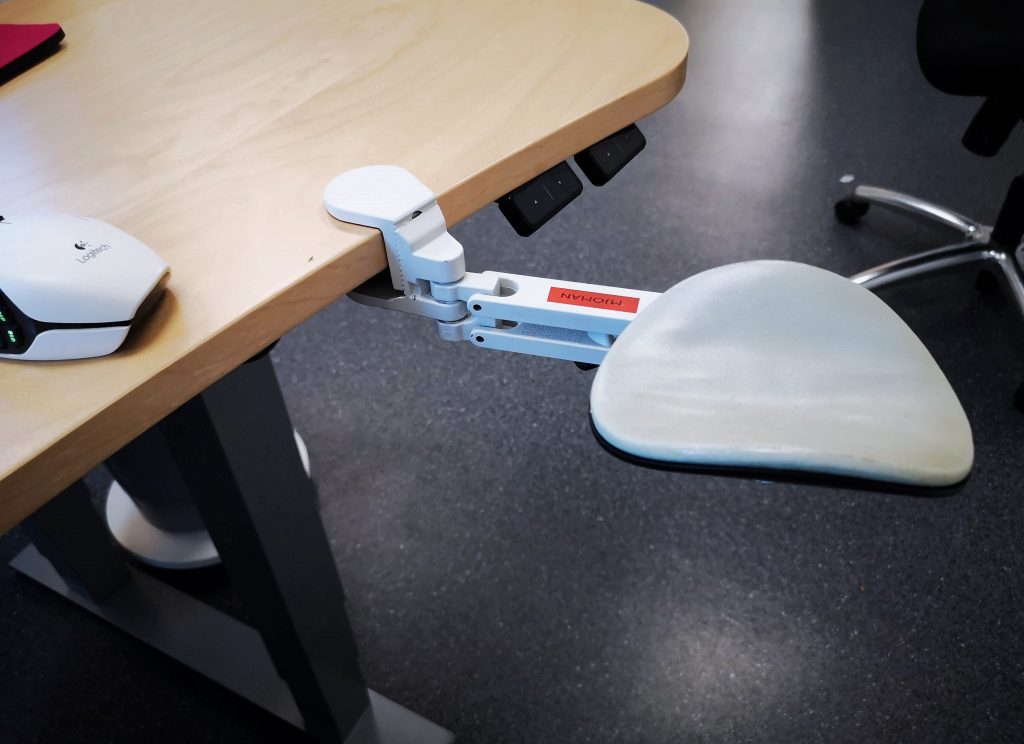
The board and other devices
As I started to add more devices to my set-up, I created a board, like a platform, on which I mounted everything together with a USB hub. This allows me to easily bring my set-up to any workstation by just plugging in a single USB cable to the computer.
All special devices, together with a traditional QWERTY keyboard, are attached to the board together with some other gadgets. For example, I have a holder for my glasses, a 64 GB USB memory stick, a stand for the dictaphone, clips for important notes, a phone holder, and a place to put the gaming mouse. I bring this board with me to anywhere I work.
Another low-tech aid that I use is a supporting lever on which I rest my right arm and thereby provides support to by shoulder. This is something I have used for many years and has probably saved me from several work-related injuries I am sure I would have suffered from otherwise, such as the common mouse arm syndrome.
People ask me if I have an injured arm when they see my lever for arm support. My usual response is that it is for preventive purposes and the reason I have never had any injuries.
When changing workplace at the hospital in Helsingborg and when I need to bring my entire workstation, I use a hardcase box that also fits my device board. This box can also hold my arm support, a coffee cup holder, a Bluetooth speaker, and more. An additional benefit with the box is that it works as a stool for colleagues who want to sit next to me when discussing cases.


What is your latest new feature of your set-up?
My latest project is a holder for the dictaphone. Now that we have changed from Nuance to the Recognosco speech recognition software, I can control the voice recognition via a button on the mouse. This means that I do not have to hold the dictaphone, so I created a necklace that can hold it for me.
Many colleagues use a headset, but as radiologists we rarely need the earpieces. The headset also requires you to manually activate and deactivate it using the computer settings, which takes time. I am actually conducting this interview using the dictaphone.
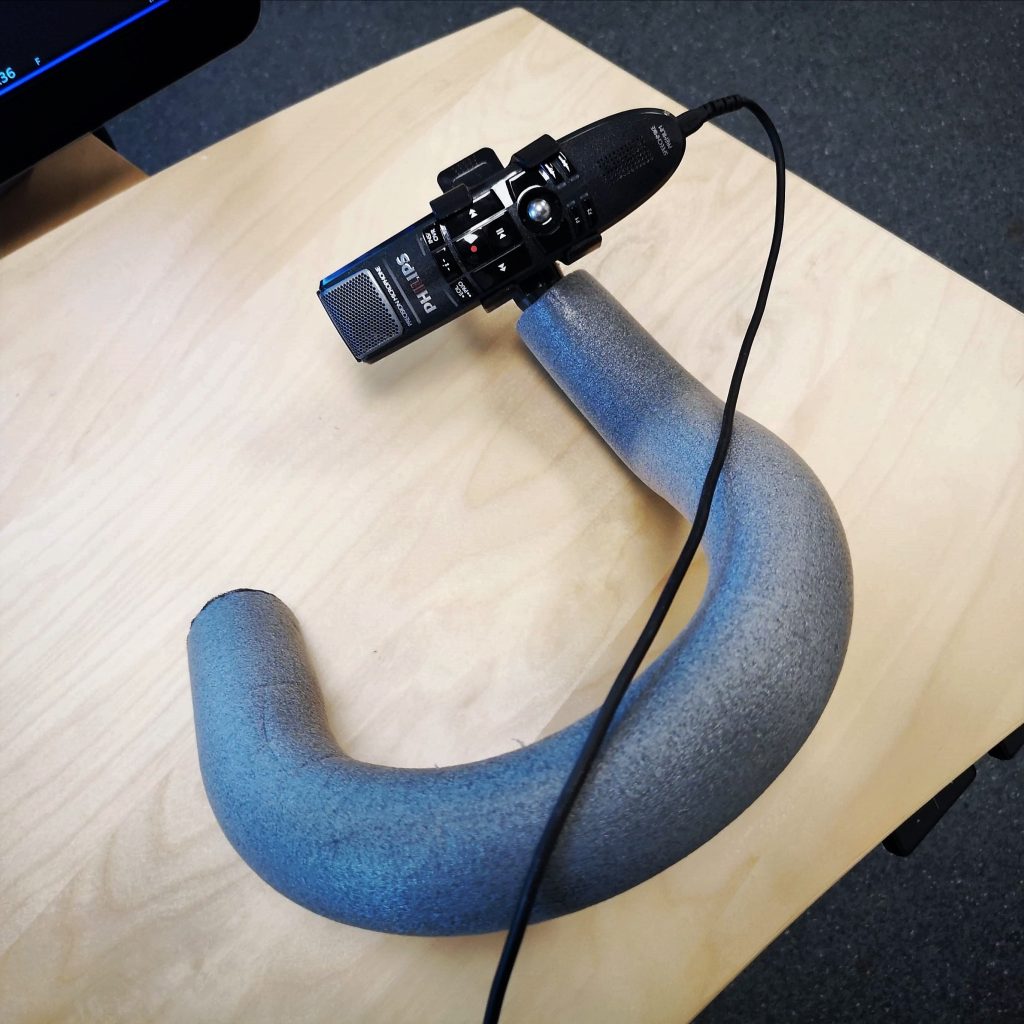
What benefits does your set-up have?
It has allowed me to become a lot faster and more precise in my work. I do not have to look for the buttons on the screen and I have minimized the need to move the mouse—instead I use shortcuts for almost everything. My set-up is even better than the standard shortcuts since I do not have to push Ctrl, Shift and a third button like you need to do for the default shortcuts. Instead, I have one shortcut per button.
It also allows me to be more precise in my review. I can create an optimal hanging layout in just a few strokes to get the best possible image review. It also improves quality for my colleagues. For example, if I dictate a CT exam, I always create a nice hanging since it is so easy for me, which will then benefit my colleagues reviewing the same exam after me. Very often radiologists do not have the time to create nice hangings of every exam.
Again, one of the best time-saving features is the ability to tilt the scrolling wheel on the mouse, which enables me to switch between layouts in the hangings very efficiently.
This set-up has improved my productivity significantly, but also the precision in my review. In addition, it makes my work so much fun and I feel more satisfied while working.
What is important to bear in mind when building a personalized workstation like you have?
As a radiologist, you might often change workplace. The most important thing if you frequently change workstation is that you do not want to have to install driver software time and time again. Instead, all devices you use must contain all the necessary drivers and have an internal memory. You just want to plug in your set-up with a USB and be good to go.
Do you see any disadvantages with tailoring your own workstation?
Not really, but it is not for everyone. It depends on your interest and personality, I would say. Some people might find it stressful just looking at my set-up, while others will love it.
The only disadvantage I have is that I need to carry my platform with me. I would probably also need to spend some extra time finding replacement parts if some of the hardware were to break and is no longer in production. But this is part of my hobby.
What does Sectra say about this?
They are totally fine with it. I never change anything within the actual system. I use the flexibility that the system offers and since I do not change the workstation or leave any traces after me, Sectra does not see it as an issue.
There was a funny incident when Sectra brought visitors from a British hospital to us in Skåne. The visitors were amazed by my workstation and thought it was a standard product from Sectra, so Sectra had to buy an entire box of gaming mice for their British customer.
If other radiologists want to rebuild their workstation, what advice would you give them?
There are several pieces of advice that I would like to share:
- Only do it if you enjoy it.
- Make it technically stable. If it keeps breaking, it will probably not save you any time.
- Do not integrate any device that requires drivers to be installed on the workstation unless you have your own personal workstation and you are permitted to add non-standard drivers/programs to it.
- Focus on creating shortcuts for the repetitive tasks you use often and automate these.
- Try to replace buttons on the screen with shortcuts. It will reduce your mouse miles significantly.
And finally, there are no limitations and the opportunities are endless. Do not just accept interface solutions that annoy you every day. A small amount of work to solve it will pay off many times over the years.
A final question—is that a treadmill you have in the background?
Yes, it is. But I never use it when I review exams, it is too hard to stay concentrated. But at work we have tried using under-desk stepper machines. 🙂
